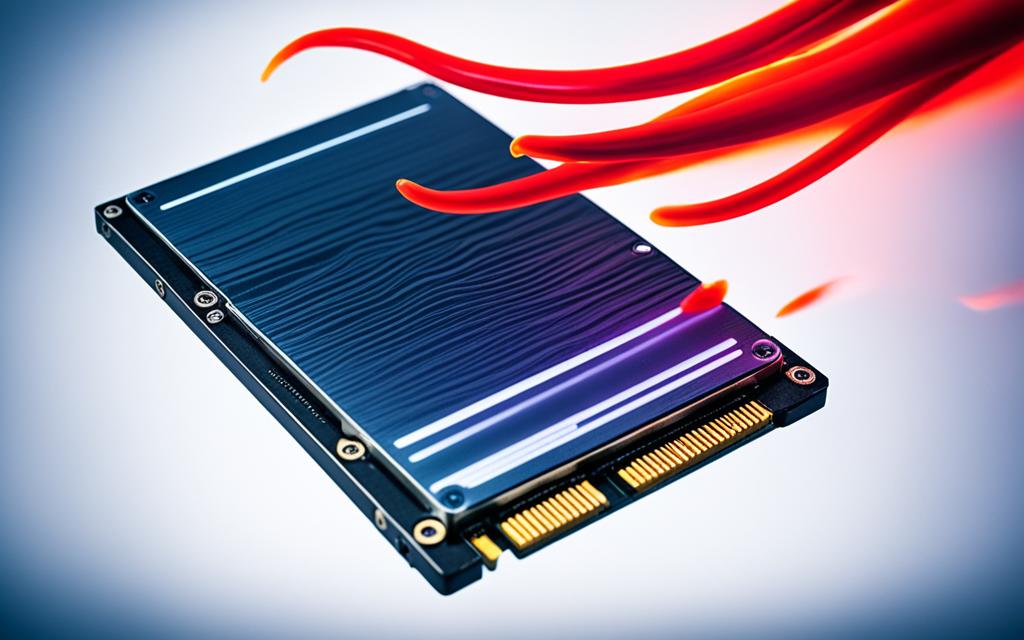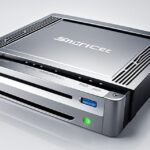Table of Contents
Solid State Drives (SSDs) have changed how we store and use data. They provide amazing speed and efficiency. Yet, they can face issues, especially with overheating. Overheating in SSDs is a real problem that affects their performance and life. The causes of SSD heat are many, including how hard the drive works and the temperature around it. It’s important to know about SSD temperature management to keep them working well.
SSDs are usually too hot if they are above 70ºC. This can cause them to slow down or become less reliable. So, it’s key for users to understand these heat risks. They must take steps to manage the heat. This helps to keep their data safe and makes their SSDs last longer12.
Key Takeaways
- SSDs should operate within a temperature range of 0°C to 70°C.
- Overheating can lead to system slowdown and data loss.
- M.2 SSDs are particularly susceptible to overheating.
- Excessive workload and poor cooling systems can exacerbate heat issues.
- Regular monitoring tools can help detect potential overheating problems.
- Keeping firmware updated can enhance SSD performance and reliability.
- Implementing cooling methods can mitigate overheating risks.
Understanding SSDs and Heat Generation
Solid state drives (SSDs) have recently made a big splash in how we store data. Compared to old hard disk drives (HDDs), they’re a big step forward. SSDs use NAND flash memory, which allows quick data access and boosts performance. Yet, they face challenges, especially with heat.
The Basics of Solid State Drives
SSDs are different because they have no moving parts. This makes them lighter and more compact. They rely on NAND flash memory, achieving rapid read and write speeds. Essential parts of an SSD include a controller. It manages data flow and talks to the NAND flash and the computer. Normally, SSDs work well at temperatures between 30-50ºC. But, going over 70ºC can hurt their performance3.
How SSDs Work and Their Components
SSDs store data in memory cells. A controller makes sure this data is ready when needed. Idle SSDs use little power, under 1W. But intense use can turn power into heat4. Heat gets worse when many chips are packed together. Without control, high heat can damage the SSD, leading to data loss.
Does SSD Get Hot?
Solid State Drives, or SSDs, are crucial in today’s computers. But it’s important to know how they handle heat for the best performance. SSDs work best between 0°C and 70°C. If they get hotter than 70°C, it can cause problems and even damage3. Typically, SSDs are fine up to 158ºF (70ºC). But, usual working temperatures are around 86-122ºF (30-50ºC)3. It’s worth noting that during heavy use, SSDs might exceed 70°C5.
Operating Temperature Ranges for SSDs
The right temperature is key for an SSD’s performance and life. If an SSD gets up to 70 degrees Celsius, it starts to slow down to cool off5. This thermal throttling can really lower how well the SSD works if it’s too hot often. To help, many use heat sinks made of aluminium5. These heat sinks don’t make noise or add much size but are great for managing heat.
Heat Generation in Different SSD Types
SSD models don’t all make the same amount of heat. M.2 NVMe SSDs, for example, get hot faster than SATA ones do. This is because M.2 drives usually don’t have good cooling on their own5. Without a heat sink, a Gen3x4 SSD can hit 70 degrees Celsius in just three minutes. Data centres and powerful computers often run into heat problems that can cause failures3. Using good airflow and heat sinks helps keep SSDs working right and cool3.
Common Causes of SSD Overheating
It’s essential to know why SSDs overheat to manage their temperature well. Factors like electrical resistance and how much work the SSD does play big roles. Since we depend a lot on solid-state drives, we must tackle these issues. Doing so helps to keep them running well and reliably.
Electrical Resistance and Heat Production
The main reason SSDs get too hot is electrical resistance. This happens when they’re busy reading and writing data. Each action makes them warm up. For example, a Gen3x4 SSD might hit 70 degrees Celsius in just three minutes if the room is 25 degrees Celsius. And, Gen4x4 models can reach this heat level in only 40 seconds6. This shows how quickly they can warm up because of electrical resistance.
Impact of Workload on SSD Temperature
When SSDs have a lot to do, their temperature goes up. This is especially true for tasks like gaming, video editing, or analysing data. The more work an SSD has, the hotter it gets. This can harm data safety and the SSD’s life if it stays too hot for too long6. Overheating can even cause some SSDs, like M.2 and mSATA types, to fail7.
Factors Exacerbating Heat Issues
Other factors make it harder to keep SSDs cool. Poor design or tight spaces can limit airflow. Heat from nearby parts and not having good cooling add to the problem. High room temperatures also make SSDs more likely to overheat. This can lead to them not lasting as long and might mean needing help to get data back if they overheat7. Understanding and dealing with these factors can make SSDs perform better for longer.
Effects of Overheating on SSD Performance
Overheating is a big problem for solid state drives. It affects their performance and how long they last. Knowing how overheating impacts SSDs can help users keep their devices safe and working well.
Understanding Thermal Throttleing
SSDs start to slow down when they get too hot, around 70°C, through a process called thermal throttling8. This makes the read/write operations slower, which cools the device but also drops its performance9. This means tasks like moving files can get noticeably slower. For example, a test with a Corsair Flash Voyager Mini SSD showed its temperature went up to 44°C during a file transfer, causing the transfer speed to vary between 32MB/sec and 66MB/sec10.
Impact on Data Integrity and Endurance
Overheating affects more than just speed; it also risks the data’s safety9. High temperatures can cause errors that put stored data at risk. If it gets too hot, this can lead to data loss and worries about how long the SSD will last. Companies like Corsair and Adata have updates to help control the heat9. This heat also wears out the memory cells faster, making the SSD fail sooner than expected8.
Keeping an eye on the heat is key for SSD users, especially with the latest SSD technology. Monitoring SSD temperatures helps keep the device running smoothly and last longer.
| Temperature (°C) | Action Taken | Impact on SSD Performance |
|---|---|---|
| 28 | Normal operation | Ideal performance |
| 39 | File transfer ongoing | Performance beginning to decline |
| 44 | Continued file transfer | Significant performance throttling occurs |
| 70 | Thermal throttling engages | Read/write speeds heavily impacted |
| Above 70 | Potential shutdown | Risk of data loss and SSD failure |
How to Monitor SSD Temperatures
It’s important to keep an eye on SSD temperatures to keep them running well. They work best when kept between 20 to 60 degrees Celsius. Regular checks with SSD monitoring tools are recommended to stay within this range11. EaseUS Partition Master is great for checking SSD temperature and health. It warns you if the temperature gets too high, helping to avoid damage11.
Tools for Checking SSD Health and Temperature
Windows 10 offers a handy tool for users with Insider build number 20226 or newer. It lets you monitor your SSD temperatures easily11. For those on older builds or needing more details, third-party programs are a good choice. They are vital for monitoring external drives, which Windows can’t track.
Signs of Overheating to Look For
Be alert for signs of your SSD getting too hot. These signs include a drop in performance, frequent warnings about heat, and strange noises11. If temperatures go above 70°C and stay there, the SSD could be permanently damaged. This would affect its performance and the safety of your data11.
Noticing these signs early means you can cool down your SSD. You might improve airflow or attach a heatsink. These steps can keep your SSD running smoothly5.
FAQ
Do SSDs really overheat during operation?
Yes, SSDs can get too hot, especially the NVMe types. They heat up when they’re busy reading and writing data. This happens because of electrical resistance. If they reach above 70°C, they might slow down. This can also shorten their life.
What factors contribute to SSD heat generation?
SSDs get hot for several reasons. One is the electrical resistance they face when working hard. They also have a compact design which doesn’t help. Poor airflow and being close to other hot parts in the computer also play a part.
What is the optimal operating temperature for SSDs?
SSDs work best when they’re kept cool, from 0°C to 70°C. Going hotter can make them overheat. This not only drops their performance but can also shorten their life.
How does thermal throttling work in SSDs?
Thermal throttling is a safety feature in SSDs. It slows them down when they get too hot, around 70°C. This protects them but means they can’t work as fast during heavy use.
What tools can I use to monitor my SSD’s temperature?
There are tools like EaseUS Partition Master that keep an eye on your SSD temperature. They alert you if it gets too hot. Checking regularly helps keep your SSD from overheating and running smoothly.
What signs indicate that my SSD may be overheating?
Watch out for things like sudden performance drops, repeated thermal throttling warnings, strange noises, or system troubles. Spotting these early can help you act to prevent damage.
Are there different heat management solutions for NVMe and SATA SSDs?
Yes, M.2 NVMe SSDs heat up faster than SATA SSDs. They often need extra cooling, like heatsinks, to keep them cool. This helps them work better and last longer.
How does excessive heat affect SSD data integrity?
Too much heat is bad for SSDs. It can cause more errors and even loss of data. Over time, it can hurt the memory cells, leading to failure and cutting their lifetime short.
Source Links
- https://www.easeus.com/computer-instruction/can-ssd-overheat.html – SSD Overheating? Check Full Explanation and Reasons!
- https://www.partitionwizard.com/news/can-ssd-overheat.html – Can SSD Overheat? How to Avoid & Deal With the Issue? [Solved]
- https://datarecovery.com/rd/how-heat-affects-a-solid-state-drive-ssd/ – How Heat Affects a Solid-State Drive (SSD) – Datarecovery.com
- https://forums.tomshardware.com/threads/do-ssds-heat-up.685341/ – Do SSD’s heat up?
- https://www.techtarget.com/searchstorage/post/Understand-SSD-overheating-and-what-to-do-about-it – Understand SSD overheating and what to do about it | TechTarget
- https://www.datarecovery.net/articles/ssd-overheating-data-loss.aspx – The SSDs subjected to high temperatures can adversely impact data retention – ACE Data Recovery Article
- https://www.techchef.in/top-reasons-for-ssd-overheat/ – Top reasons for ssd overheat
- https://www.allion.com/ssd-hirota-test/ – Does High Temperature Kill HDD and SSD? | Allion Labs
- https://nascompares.com/news/phison-e26-controller-and-gen5-ssd-overheating-is-your-ssd-effected/ – Phison E26 Controller and Gen5 SSD Overheating: is your SSD effected?
- https://arstechnica.com/civis/threads/sandisk-extreme-external-ssds-what-causes-the-overheating.1485083/ – Sandisk Extreme external SSDs-what causes the overheating?
- https://www.easeus.com/partition-master/check-ssd-temperature-windows-10.html – How to Check SSD Temperature in Windows 10/11 [2024 Step-by-Step Guide]








